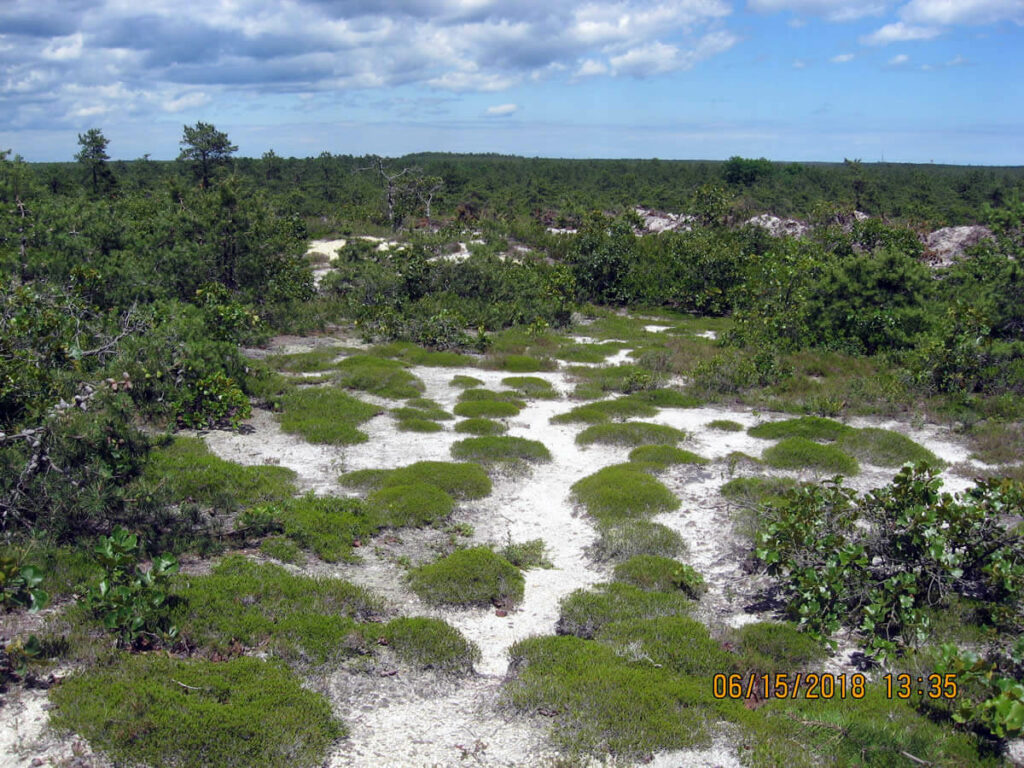The DEP Office of Natural Lands Management (ONLM) has been working with Fish and Wildlife, NJ Forest Fire Service (NJFFS) and other partners at East Plains Natural Area (EPNA), Stafford Forge Wildlife Management Area to enhance populations of the state endangered plant broom crowberry (Corema conradii). This management has included ecological forestry and burning to restore open canopy habitats in the globally rare dwarf pine plains ecological community, and mechanical scrapes to create sandy early successional openings which protect broom crowberry from fire and provide ideal habitats for the species to colonize.
Broom Crowberry is restricted in New Jersey to the central Pinelands, mostly in open canopy dwarf pine plains and concentrated within sandy openings. It is a fire sensitive, early successional ground cover plant found along the North Atlantic coast, relying on fire, disturbance or rock outcrops to create its open habitats. Historically more abundant in the dwarf pine plains, broom crowberry has a complicated relationship with fire in the NJ Pinelands, which helps maintain its habitat but sometimes destroys its populations. Due to prolonged fire exclusion, altered fire regimes and fewer man-made disturbances, broom crowberry and open canopy dwarf pine plains with sandy openings have been declining for decades, putting both species and habitat at risk.
In 2018, the DEP began creating multiple small bulldozer scrapes adjacent to broom crowberry populations in EPNA. These create patchy bare sand openings about one acre in size. Scrapes provide early successional habitats where new broom crowberry plants can colonize and thrive, as well as provide sandy firebreaks that shield existing populations from the spread of catastrophic fires.
These scrapes must be placed within several feet of existing populations to facilitate colonization, since broom crowberry seeds usually disperse only very short distances. The scrapes restore persistent sandy openings typical of historic pine plains which were naturally created by frequent fires, severe fire events, gravelly hilltops, erosion on slopes and animal burrows, as well as by human disturbances such as charcoaling, sand roads and bulldozer scrapes. Some firelines are also being installed around broom crowberry populations to help protect them from prescribed fires and wildfires.
Over the past decade, aging pine plains with a taller closed canopy have been managed in buffers surrounding broom crowberry populations using ecological forestry cutting with slash removal and forestry mowing to mechancially promote a more open, stunted pine plains canopy. Prescribed fires are excluded until after fuel loads are reduced and open pine plains restored to facilitate broom crowberry fire survival.
High intensity prescribed burning has also been applied by NJFFS in pine plains, mostly where broom crowberry is absent, to reduce dangerous fuel loads and wildfire hazard, and to restore more open pine plains habitats. Thousands of acres of pine plains have been burned “hot” since 1986. Broom crowberry populations burned by hot fires, especially in long-unburned stands, typically suffer a major setback, with all or most broom crowberry plants killed by fire. This is followed by slow incomplete population recovery from seed, at best, or complete destruction if seeds are killed by catastrophic fires. Where larger broom crowberry populations still persist on the landscape, a combination of repeated cutting with slash removal and adjacent bulldozer scraps are recommended in buffers before prescribed burning is applied, to avoid destroying or degrading our last remaining populations.
For more information, please contact Andrew.Windisch@dep.nj.gov.
 Official Site of The State of New Jersey
Official Site of The State of New Jersey

